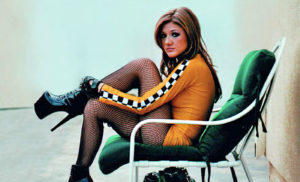Just north of the Strand, behind where the Australian High Commission now stands, there used to be what the press called “a fetid, miserable lane”. One of 19th-century London’s more disreputable districts, it housed the poor, the criminal, the prostitute and the disgraced. It was all demolished over a century ago, but there was a time when Holywell Street was the most notorious road in the country. Because it was here, in the 1840s, that the British pornography industry was born.
Its father was William Dugdale, who had been a rising star during the political ferment in the hard years that followed the Napoleonic Wars, which E.P. Thompson called “the heroic age of popular radicalism”. Dugdale gave his first public speech to a mass rally in 1818, calling for armed insurrection against the state. He was 18 at the time. He was also mixed up in the Cato Street Conspiracy, a plot to assassinate the cabinet, and as a publisher he brought out the first edition of Robert Wedderburn’s abolitionist pamphlet, The Horrors of Slavery (1824).
But the radical moment passed, the market for revolutionary tracts collapsed, and Dugdale turned instead to publishing obscene literature to make a living. By the 1840s, he had established himself in Holywell Street as importer and distributor, as well as publisher and retailer, with a thriving mail-order business on the side. An 1851 raid on one of his seven shops saw the seizure of goods worth, allowing for inflation, £350,000 at today’s prices. This was new. The trade in obscenity had previously been centred on market stalls and itinerant salesmen; there had never been anything on this industrial scale before. Mostly, Dugdale’s trade was in prints, etchings and books — with titles such as Confessions of a Voluptuous Young Lady, The Quintessence of Birch Discipline, The Curious and Diverting History and Adventures of a Bedstead. But he also published The Exquisite, the first recognisably modern pornographic magazine. Others followed him and by the 1850s, Holywell Street had become a byword for filth.
Inevitably, all this brought Dugdale into conflict with the law. He was repeatedly sentenced on obscenity charges, normally getting two years’ hard labour each time, though it is uncertain how long he actually served. He had some influential men among his customers, and a tendency to get out of jail on technicalities.
Anyway, he saw the prosecutions as proof that he was still an irritant to all the right people: the religious and secular authorities. Their condemnation of pornographic literature was rooted in a concern that it would fall into the hands of the working class, at a time when literacy was spreading rapidly. Time and again, judges thundered that this celebration of lust, at the expense of family and parenthood, was “subversive of the foundations of civil society itself”. And since Dugdale was subversive, he saw pornography as a continuation of the political struggle by other means.
His enemies were also crusaders, part of the great evangelical revival that came to define Victorian Britain. Most of the prosecutions were initiated by the Society for the Suppression of Vice, co-founded by William Wilberforce in 1802 to combat all manner of immorality. By the middle of the century, though, the SSV was in decline, its membership dwindling, its funds exhausted. Nonetheless, its secretary, Henry Prichard, engaged in a decades-long war with Dugdale, as the two men brought cases and counter-cases against each other. Prichard, Dugdale claimed, allowed himself to be bribed by his rival shopkeepers in their attempts to avoid prosecution; he was also reputed to re-sell onto the market the material seized in raids. There was sufficient suspicion to prompt the passing of the first-ever Obscene Publications Act in 1857, which was specifically aimed at suppressing Dugdale, while also clipping the wings of the SSV: new powers of seizure were given to the police, assumed to be less susceptible to corruption.
Dugdale carried on trading, and carried on being prosecuted, right up to his death, in 1868, while serving yet another jail term. This time the charge sheet had included obscene photographs for the first time; even as an old man, he was still moving with the times. Dugdale has never been seen as a political hero. Even at the time, few of his radical comrades approved of his business. But the state saw him as a genuine threat, and it saw pornography as dangerous. One of the exhibits at Dugdale’s last trial was John Cleland’s novel Fanny Hill, published a century earlier and still banned a century later; the works of, say, Karl Marx faced no such suppression.
A century later, at the dawn of what became known as the Golden Age of Porn, much of the story was repeated. Dugdale’s belief that he was fighting the good fight was again evident in the political counterculture of the Sixties, especially in America. “Pornography was seen to be a vehicle of liberation,” remembered Andrea Dworkin. “Anything they tried to stop us from doing, we did.” The reality turned out to be grubbier than the idealism. Dworkin and other early feminists were horrified when former comrades, with whom they had marched side-by-side on anti-Vietnam War demos, embraced the money to be made from porn. “Suddenly they weren’t so anti-capitalist anymore.” The sense of betrayal fuelled much of the feminist anti-porn campaign that followed.
Meanwhile in Britain, Suck magazine — arty, radical, pro-feminist — was launched in 1969 by figures from the alternative press. It only lasted eight issues, closing after Germaine Greer lambasted her comrades on the editorial staff as “pseudo-revolutionary”. But Suck had been strictly underground anyway, published in Amsterdam, since it was far too explicit to be legal in Britain. That was the key difference: America had a First Amendment guarantee of free speech, which by the Seventies was being successfully invoked to defend porn; Britain did not.
The second Obscene Publications Act, of 1959, did largely free the written word, but visual imagery — as various trials established — was far more restricted. In America, the film Deep Throat, starring Linda Lovelace, was a massive box-office hit with its explicit sex scenes. It was banned outright in Britain, which had to settle for the home-grown Come Play with Me, a comedy that went a little further than Carry On Camping, but not much further.
It wasn’t always clear what was permitted, but the fear of prosecution meant that the trade self-censored to be on the safe side. Depictions of an erect penis, for example, were avoided, guaranteed to get a conviction. Accordingly, an eye was always kept on “the angle of the dangle”. Indeed, there operated a semi-joking Mull of Kintyre Test: anything steeper than a map of the Scottish peninsular was deemed to be too erect. In this semi-legalised world, the imagery was less explicit than it had been in Dugdale’s day, when everything was banned and one might as well be hanged for a sheep as a lamb. The result was that the permitted material reflected the dominant values of a still sexist society: unable to show intercourse, it opted for willing and waiting women. In such circumstances, it was hard to see pornography as “a vehicle for liberation”.
Instead, the rapidly growing porn industry was concentrated in the hands of the criminal fringe, who had been running strip-clubs in Soho since the turn of the Sixties, and now added sex shops, magazines and movies to their property portfolios. Following Dugdale’s model of multiple outlets in a tightly defined area, they made Soho synonymous with porn, just as Holywell Street — less than a mile to the east — had once been.
As society became more liberal in sexual matters, the magazines that were sold over the counter in Soho gradually migrated to licensed sex-shops elsewhere in the country and, more significantly, to the top shelves of newsagents, where their presence became hard to ignore. Softcore porn became normalised to the extent that it could be joked about on mainstream television. In a 1977 episode of sitcom George and Mildred, she inadvertently donates his stash of magazines — including copies of Nudge, Wink and Titter — to the vicar’s jumble sale, leaving him to fret over their loss: “Be hard to replace some of them. Especially the Swedish ones.”
That reference to Scandinavian titles suggested something far more serious: the hardcore magazines and films that were smuggled in from the Continent. (A mark of quality was said to be if it smelt of bacon, since that meant it had been imported on a container ship from Denmark.) This stuff was illegal, of course, but it continued to arrive, partly because the profit margins were astronomically big, and partly because there were surprisingly few prosecutions. And that was because, in another echo of the 1850s, those who were supposed to be policing the industry were actively supporting it. Between 1975 and 1976, 15 members of the Obscene Publications Squad of Metropolitan Police were jailed for taking bribes and effectively running a protection racket. The legal definition of obscenity is material likely to deprave and corrupt; that has always been a difficult concept to pin down, but what is certain is that porn has repeatedly corrupted the guardians of society.
William Dugdale had seen pornography as a way of attacking the power structures of society; now Andrea Dworkin was arguing that it was actually an expression of those power structures. Porn, she said, was “the nerve centre, the Pentagon” of the war against women, the place “where strategies of sexual abuse were both planned and communicated”. Previously, the church, social norms, a shared morality — these had been enough to enforce male power, but they had been weakened by the rise of the women’s movement, and heavier weaponry was required. The modern proliferation of porn was a reaction to feminism, an attempt to intimidate women into subservience.
Further, it was inherently totalitarian and genocidal. “Dachau brought into the bedroom,” was Dworkin’s assessment of pornography, an image that was adopted by others. In the Nineties, former editor of The Times William Rees-Mogg was shown the material being broadcast on European satellite TV station Red Hot Dutch; he was horrified: “It reminds me of films about concentration camps.”
For others, pornography defied rather than represented repressive regimes. Porn may have become an established part of life in America and Britain, but it was still being ruthlessly suppressed in the communist Soviet Union and in apartheid South Africa. When those systems fell in the Nineties, there was an explosion of porn comparable to that in the West a couple of decades earlier. The development felt like a manifestation of freedom.
Today, North Korea and Iran are not noticeably tolerant of pornography. It is still seen as subversive, a threat to religious and political control. In the liberal, individualistic world of post-Christian Britain, on the other hand, criticism has increasingly centred on the impact on the consumer. With the unprecedented availability of porn on the internet, are children acquiring a distorted, corrupted vision of sex? Is the instant hit of digital porn inherently addictive? Again, these concerns are not entirely new. Some 220 years ago, prosecuting counsel William Garrow, acting for the SSV, cautioned that obscene books and pictures were a very real danger to “young persons of both sexes, particularly of the female sex, addicting themselves to such publications”.
So, how subversive is porn? Historian Donald Thomas argued that it should be seen as akin to satire, attacking those things that are considered sacred to society. In William Dugdale’s day, incest was a favourite theme, a way of making light of 19th-century family values. It also meant that women were depicted as actively enjoying sex, something that was not spoken of in polite society.
The tone now is far more aggressive than it was then, or in the Seventies. Not all pornography is anti-women, but there is more overt misogyny in material aimed at men than there used to be — a response to the rise of women in employment and society. Lesser trends illustrate the same point: the continuing growth of cuckold porn, for example, or even the appearance, following #BlackLivesMatter, of fantasies centred on slave-owner Edward Colston.
The subversion, in other words, is negative and reactionary. Porn delights in poking at conventional morality — not in pursuit of revolution, but illicit thrill. The primary aim is arousal, the secondary to ridicule human aspirations to virtue. It is also remarkably ineffective in its subversion. Generations of those addicts that William Garrow warned about have been and gone. Holywell Street rose and fell, Soho rose and fell, and through it all, civilisation survived. Society has changed in the process, but porn, despite all the fears, has reflected, not initiated, those changes.
Disclaimer
Some of the posts we share are controversial and we do not necessarily agree with them in the whole extend. Sometimes we agree with the content or part of it but we do not agree with the narration or language. Nevertheless we find them somehow interesting, valuable and/or informative or we share them, because we strongly believe in freedom of speech, free press and journalism. We strongly encourage you to have a critical approach to all the content, do your own research and analysis to build your own opinion.
We would be glad to have your feedback.
Source: UnHerd Read the original article here: https://unherd.com/




